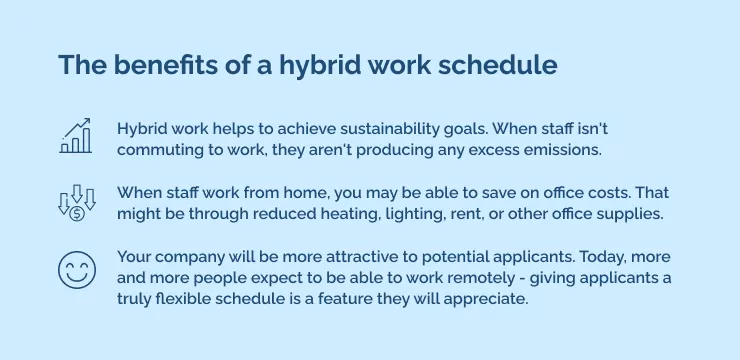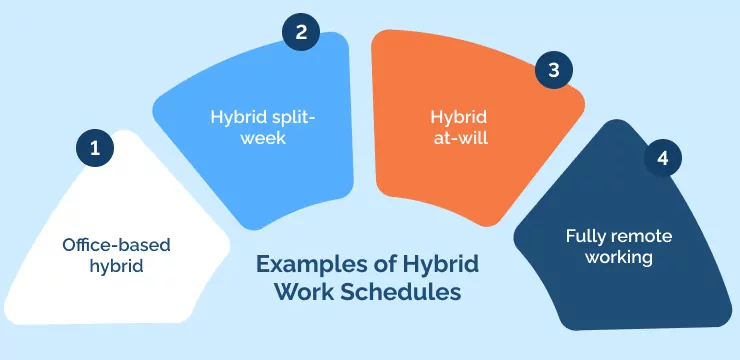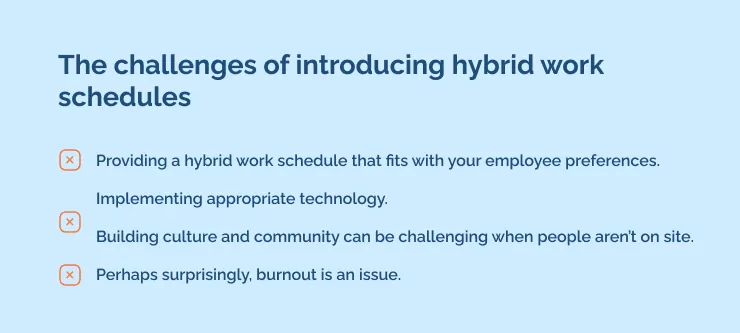
“Working from home” is nothing new. But a few years ago, no one could have predicted the scale of hybrid working. Thanks to leaps forward in technology (and just a little help from the coronavirus), remote work is now a real option for many people.
Change management can be difficult when it comes to remote working. Many companies are now facing the challenge of organizing their teams while ensuring everyone is on the same page.
However, office work isn’t as simple as during the pandemic. Now that working in person is acceptable, a hybrid work model must balance the opportunities and challenges of simultaneously working online and in the office.
That’s where a hybrid work schedule comes in. Hybrid work schedules help to balance on-site and remote work. They’re a vital tool for creating a clear hybrid working strategy – and this article will explain why.
At the start, it will go back to basics and explain what a hybrid work schedule is, why it’s important, and its benefits. Then, we’ll look at some of the key examples of hybrid work schedules. Finally, we will remind ourselves of the challenges of creating hybrid work patterns that suit everyone in your organization.
Whether you’re hoping that hybrid work will improve employee experience, reduce your on-site costs, or bring in more applicants to your jobs, get your hybrid work schedule right, and the rest will follow.
What is a hybrid work schedule?

Hybrid work is a type of work in which staff combines work at home and their office.
Although many people discovered hybrid work for the first time during the global pandemic, it has been possible since the 1970s. Fifty years ago, limited technology meant working from home was a rare privilege. But today, the superfast internet and cloud computing make it possible for many workers.
Employees usually like hybrid work. All the same, it makes some aspects of work complex. For a team with many hybrid workers, the manager could lose track of who is at home or who is meant to be in the office.
A hybrid work schedule helps to solve such problems. A clear schedule lets each worker know when they should come into the office and when they can stay home. The schedule balances time and location: ensuring staff are available in the right place and at the right time.
Creating your schedule is not easy, but it’s an important part of your hybrid strategy.
The benefits of a hybrid work schedule

Some managers cling to the assumption that staff do more work on-site than when they are working remotely. This is a big mistake.
Gartner’s research from 2022 makes things very clear: a human-centric hybrid work model reduces employee fatigue, increases retention, and improves the chances of positive performance.
Beyond staff performance, a good hybrid work schedule can help you find numerous other organizational benefits. For example:
- Hybrid work helps to achieve sustainability goals. When staff isn’t commuting to work, they aren’t producing any excess emissions.
- When staff work from home, you may be able to save on office costs. That might be through reduced heating, lighting, rent, or other office supplies.
- Your company will be more attractive to potential applicants. Today, more and more people expect to be able to work remotely – giving applicants a truly flexible schedule is a feature they will appreciate.
Examples of Hybrid Work Schedules

So – hybrid work is a very useful asset for your company.
But there are many ways to implement hybrid work. In this section, we’ll take you through a few different methods, including:
- Office-based hybrid
- Hybrid split-week
- Hybrid at-will
- Fully remote working.
Your hybrid work schedule doesn’t have to have a name. But, it’s useful when you have to explain to your staff or potential staff what you expect them to do.
Office-based hybrid
The office-based hybrid work schedule is a model in which the central office space remains the primary location for work. Employees are permitted to work remotely on an ad-hoc basis, but for the most part, they work from their desks in the office.
This model is relatively easy to manage, as it maintains the traditional structure of an office-based work environment. However, some employees may feel that this model is not very different from the old-fashioned method of office-based working.
While the office-based hybrid work schedule offers some flexibility, it may not be enough to satisfy those seeking a more significant change in their work-life balance.
Additionally, the reliance on a central office space will keep real estate costs high – while reducing the geographical reach for new applicants.
Hybrid split-week
The Split-week hybrid schedule is a great way for companies to provide staff with a reliable working pattern. With this model, the team will spend a determined number of days at the office each week while working at home for the rest. This allows employees to plan their personal and professional lives around their working hours.
This model is not very flexible. It still demands that people are present for particular hours. Moreover, the division of the week might be decided by the company or by the manager of specific units. Individual employees may not get a say in their working patterns.
However, it means that staff gets many advantages of home working while still keeping a clear foot in the door of their workspace.
Hybrid at-will (or “design your own”)
In this model, the company prioritizes remote work. That means that it’s normal to have meetings online.
So how is hybrid at-will different from fully remote work?
With hybrid at-will, the company keeps on to an office space. The space can be used in various ways: to meet with clients, hold interviews, and celebrate key successes.
This is especially useful for smaller teams – and those with strong individual emphasis.
Week-by-week
A week-by-week hybrid work schedule is a flexible model that balances weekly office-based work with remote work. This model has been used for some time and involves spending one week in the office and the next week working from home. During the week in the office, employees can attend meetings, communicate with colleagues, and touch base with all parties involved in their work. During the week at home, employees can plan, organize, and focus on individual tasks without distractions in the office.
This schedule is effective because it allows employees to balance office-based collaboration and focused remote work. It also offers a level of predictability to help employees plan their schedules and avoid conflicts. However, it may not work for all employees, particularly those who prefer a more consistent schedule or live far away from the office.
Fully remote work schedules
The fully remote hybrid work schedule is a model in which no physical office exists, and all employees work remotely from their homes or other locations. This model is simple and cost-effective, eliminating the need for physical office space and associated costs. This model has other benefits, such as increased flexibility, improved work-life balance, and the ability to hire talent from anywhere in the world.
However, there are also challenges to consider. Building a strong team culture can be more difficult when employees are not physically together, and creating a sense of belonging and collaboration may be harder. Communication and collaboration can also be more challenging when employees are not in the same location. Companies must ensure they have the right tools and processes to facilitate effective communication and collaboration in a fully remote work environment.
The challenges of introducing hybrid work schedules

If you want to adopt a hybrid working schedule – good choice! Hybrid working has many benefits for the staff and organization alike.
Just remember that effective hybrid working also requires a lot of planning. As Lynda Gratton explained in a 2021 HBR article, hybrid working can include tasks, employee behavior, workflows, and inclusion.
Some specific challenges you might face:
- Providing a hybrid work schedule that fits with your employee preferences. Some people would love to spend 90% of their time working at home – but others need to come into the office for all sorts of reasons. A hybrid work schedule must be flexible enough to accommodate everyone.
- Implementing appropriate technology. For most work situations, an efficient cloud computing system is a “must have” – it won’t be possible to revert to on-site servers if the system goes down one day.
- Building culture and community can be challenging when people aren’t on site. This is different for staff at different levels. Employees who have worked with a company for a decade may have a more established network of contacts than a new hire.
- Perhaps surprisingly, burnout is an issue. 2022 research from Gartner suggested that as much as 50% of hybrid (or remote) employees still struggle with work-life balance.
Hybrid work solves a lot of problems. But it is not a magic bullet. A hybrid work schedule should be part of your organization’s much bigger strategy for human-centered work. If you’re already flexible with work, collaborate effectively, and manage empathetically, you have a much better chance of success.
Hybrid Work: The Bottom Line
The future is still uncertain for hybrid work schedules. It is difficult to tell whether or not this is the working pattern for the future.
On the one hand, 2023 research from the US Bureau of Labor Statistics suggested that the number of people on hybrid schedules reduced dramatically from 2021 to 2022. But on the other hand, analysis from the UK’s ONS shows that more than 25% of adults reported some home working in 2023 – more than double the rate from before the pandemic.

Whatever way the world goes, it’s clear that modern leaders must think about hybrid working as a serious option. As we’ve seen, hybrid work has clear benefits: employee well-being, sustainability, and more.
And although hybrid work is not a one-size-fits-all situation, our options show an effective hybrid work schedule for your organization. There are challenges to hybrid work, but we’ve now got plenty of experience to show they can be met.
WalkMe Team
WalkMe spearheaded the Digital Adoption Platform (DAP) for associations to use the maximum capacity of their advanced resources. Utilizing man-made consciousness, AI, and context-oriented direction, WalkMe adds a powerful UI layer to raise the computerized proficiency, everything being equal.



